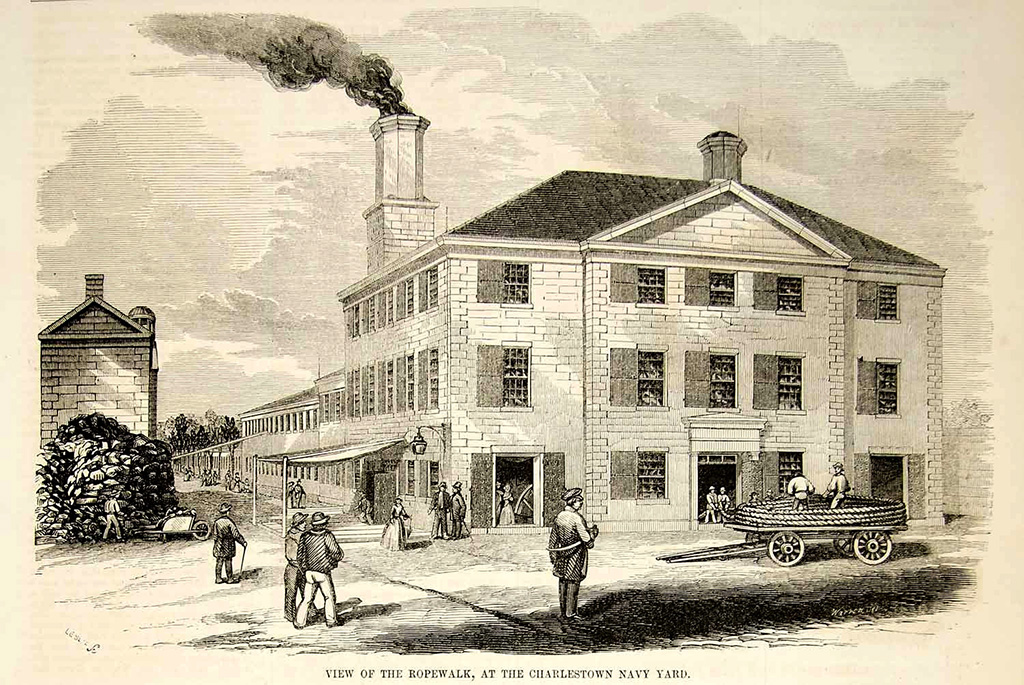

“Friday last, the cable of the CONSTITUTION frigate was conveyed on the shoulders of two hundred and ninety three men from the walk to Navy yard. It was preceeded [sic] by Col. Claghorn, and attended by a party of drums and fifes and three American ensigns.” – The Boston Gazette, and Republican Weekly Journal, September 18, 1797
Ropemaking
Twisting fibers of different materials into rope is one of the world’s oldest handicrafts. Nearly every industry needs cordage of some sort to function, be it thread for clothing, string for tying bundles, or different-sized ropes for the intricate rigging of sailing vessels. A ropemaker from England arrived in Boston in 1641 to launch the industry in the British colonies. Rope, which is made by twisting layers of fibers in opposing directions, was first manufactured in open fields at man-powered rope-laying equipment. The length of the longest piece of rope was determined by the strength of the ropemakers maintaining the twisted fibers at the laying-up equipment. By the 18th century, long wooden sheds, called ropewalks, were being used to house the ropemaking equipment and the product. A great danger in ropemaking was fire because of the prevalence of hemp fibers and dust and the hot tar used to waterproof the rope. According to Samuel Eliot Morison’s The Ropemaker’s of Plymouth: A History of the Plymouth Cordage Company, there were fourteen ropewalks in Boston by 1794. That same year, on July 30th, a fire began in Edward Howe’s ropewalk consuming it and five others, culminating in ninety-six buildings being lost altogether.
“Wednesday morning, about four o’clock, the melancholy cry of fire grated on the ears of our citizens. They immediately assembled to stop, if possible, the ravages of this destructive element. The fire caught in the Rope Walk of Mr. Howe, by an accident in heating some tar, and before the Inhabitants could be alarmed and assembled, it had gained so great a head as to render abortive all attempts to secure, from the flames, any of those elegant and valuable Rope Walk, which formed a row from Milk Street, to the west part of Fort Hill; their attention, therefore, was turned to the preservation of the dwelling houses, which from the intense heat arising from the burning tar and hemp, were taking fire in every direction at the distance of several rods…By this accident, many citizens, who by many years laborious industry had acquired a little property–in one instant the ‘twinkling of an eye’ are reduced to poverty” – August 1, 1794 [Boston] Mercury
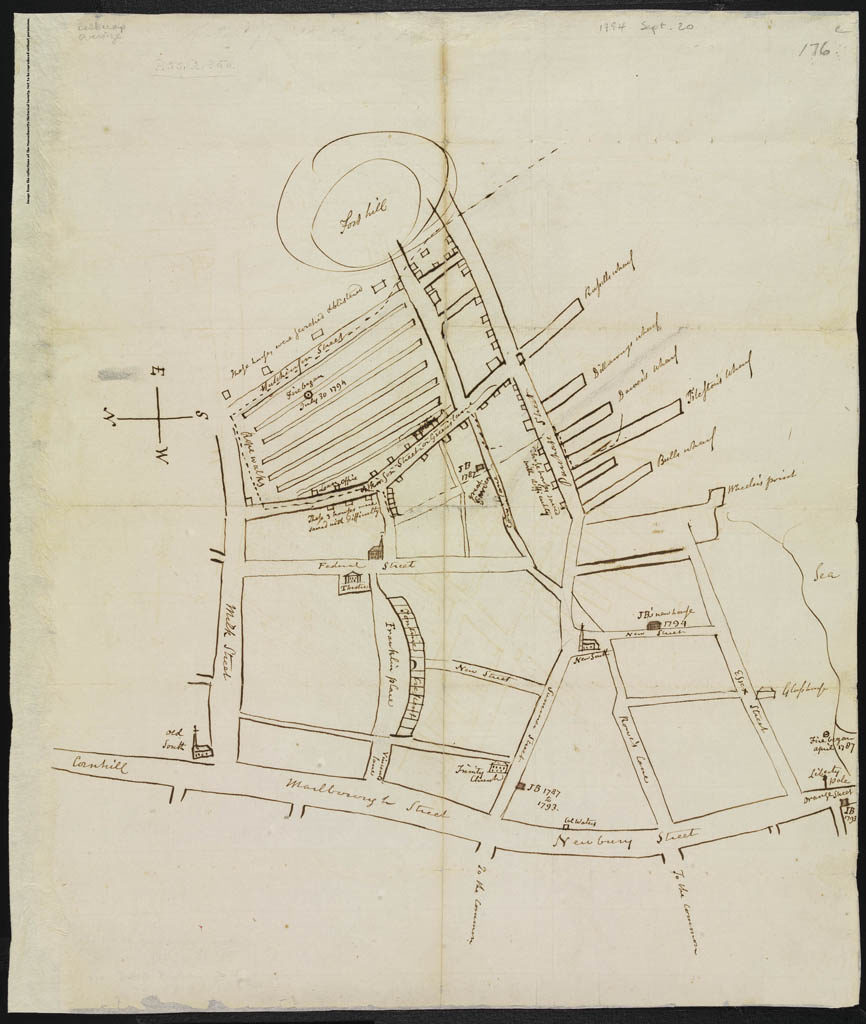
Rope for USS Constitution
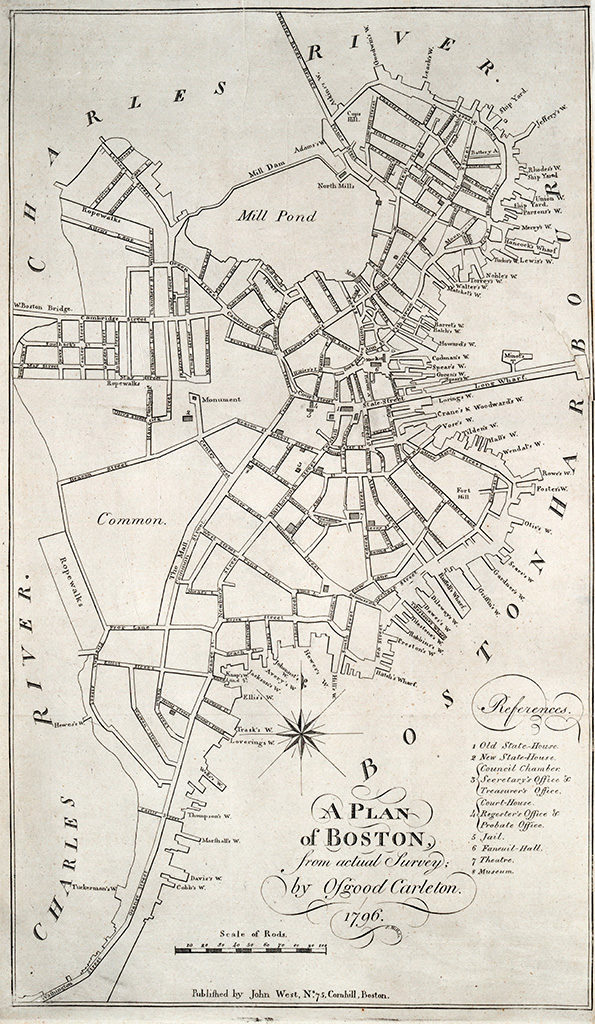
By the time USS Constitution was ready for launch in the autumn of 1797, more ropewalks had been constructed to the west of Boston Common. It was probably one of these ropewalks that manufactured Constitution‘s 22-inch circumference anchor cable which was paraded through the Boston streets to Edmund Hartt’s North End shipyard in September, 1797. Because one sailing vessel could, literally, require miles of standing and running rigging, a maritime center such as Boston needed several ropewalks to supply the required cordage.
![Antique views of ye towne of Boston, by James Henry Stark, 1901. [Courtesy Boston Public Library via Internet Archive]](/wp-content/uploads/2016/10/antiqueviewsofye00star-249-1024x356.jpg)
The United States Navy Needs Rope
During the War of 1812, the workers of the small, ill-equipped Charlestown Navy Yard struggled to fit-out and repair the Navy’s frigates for the conflict against Great Britain. Under Commandant William Bainbridge (Constitution‘s second War of 1812 captain), some much-needed improvements were made to the Yard. The Charlestown Navy Yard received its first stone wharf (the wooden wharfs were quickly decimated by ship worms), its first ship house (where the 74-gun ship-of-the-line USS Independence was built), and a three-story brick Navy Store (Building 5, the third oldest surviving building in the Yard that is the National Park Service Visitor Center today). In late 1813, Independence was far enough along in her construction to begin letting contracts for outfitting the ship. Rope for the ship-of-the-line’s rigging was needed and the privately owned ropewalks near the gates of the Navy Yard received the contracts. Bainbridge, however, urged Secretary of the Navy William Jones to consider building a public, i.e. federally-sponsored, ropewalk in the Charlestown Navy Yard in the not-too-distant future.
Twenty-eight years after William Bainbridge proposed a ropewalk for the Boston yard, the Navy assigned Commandant Charles Morris to look into the costs and feasibility of building two public fireproof ropewalks. Very specifically, Morris investigated Daniel Treadwell’s spinning machines that were employed at local ropewalks. Morris’ research helped to justify the expense of using machines to make the U.S. Navy’s cordage, as opposed to the more traditional method of hand-spinning ropemakers. Congress balked at appropriating $140,000 to build two ropewalks. In May, 1833, Jesse Duncan Elliott, the new Charlestown Navy Yard commandant, took up the ropewalk cause, articulating the need of the U.S. Navy to have complete oversight of its cordage.
“When we consider that the safety of a ship, and the lives of her crew are often dependent upon small cordage and cables it seems to be right and proper that the government should take all proper measures in their power to have the articles good.” [Jesse Duncan Elliott to Secretary of the Navy Levi Woodbury, August 13, 1833, as quoted in Edwin C. Bearss, Historic Resource Study, Charlestown Navy Yard – 1800-1842, Volume II, 729]
Congress eventually appropriated $50,000 for the Charlestown Navy Yard ropewalk’s construction in December, 1833. Alexander Parris, architect of Boston’s Quincy Market, not only designed the brick and granite structure, but oversaw the construction, too. Work on the ropewalk was well underway by June, 1835. In August, the Boston Commercial Gazette noted:
“During our visit to the [Charlestown] navy yard…we noticed one of the greatest improvements that…has ever taken place in the establishment. We allude to the new granite rope-walk…which, when completed, will be nearly 1400 feet in length. This large, commodious, and…splendid building, [is] extremely well adapted to the purposes for which it is intended….It is said that this rope-walk when finished will be competent to furnish sufficient cordage for the entire navy of the United States.”
Eighteen months later, the ropewalk was operational, as noted by the Boston Evening Transcript on November 29, 1837: “THE ROPEWALK AT THE NAVY YARD. We understand that the extensive and well constructed Ropewalk at the Navy Yard, Charlestown, went into operation yesterday, for the first time. This building does honor to the Government, and credit to the Commissioners of the Navy, under whose direction it was built…” By May of the following year, commandants of the other U.S. navy yards were notified that the Charlestown Navy Yard ropewalk was ready to “furnish considerable quantities of rigging for the use of our vessels…” [Quoted in “The Ropewalk at the Charlestown Navy Yard: A History and Reuse Plan”, Leslie Larson for the Boston Redevelopment Authority, 1987] The sloop-of-war Natchez placed the first order for topmast rigging
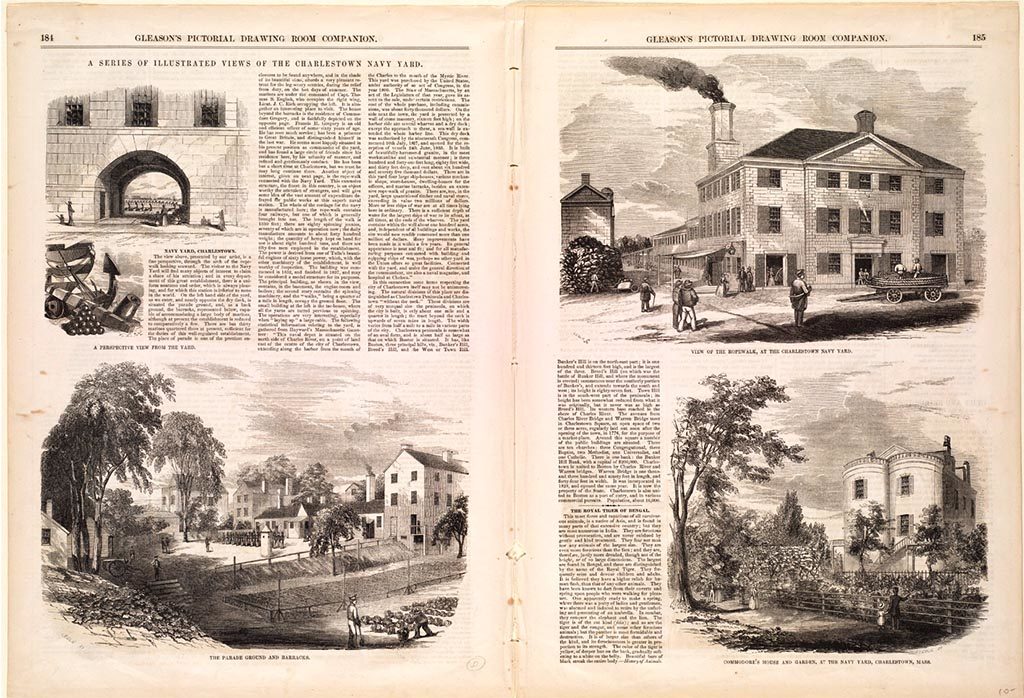
“Another object of interest…is the rope-walk connected with the Navy Yard. This extensive structure, the finest in this country, is an object worthy the attention of strangers, and will give some idea of the vast amount of expenditure defrayed for public works at this superb naval station. The whole of the cordage for the navy is manufactured here…the daily manufacture amounts to about forty hundred weight; the quantity of hemp kept on hand for use is about eight hundred tons, and there are fifty-five men employed in the establishment.”- From “A Series of Illustrated Views of the Charlestown Navy Yard” Gleason’s Pictorial Drawing Room Companion, c. 1852
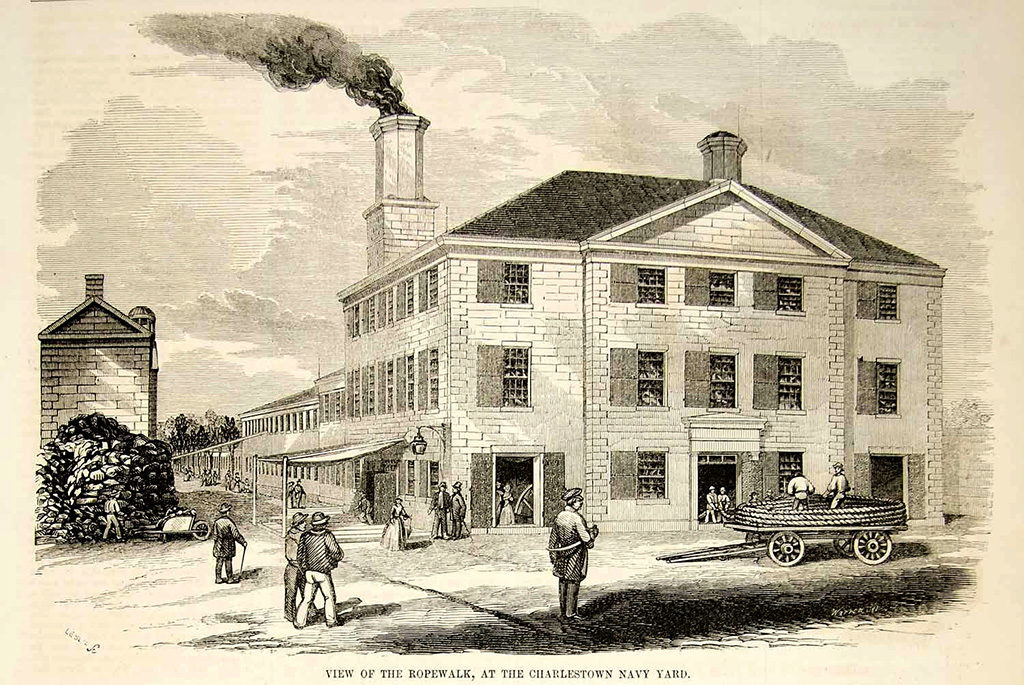
As the nineteenth century progressed, the Charlestown Navy Yard ropewalk received some upgrades. In 1858, the steam boilers in the ropewalk were removed and steam power then came from the enlarged Coal House which became the Boiler House. And between 1856 and 1866, the second floor of the ropewalk was extended. In October, 1869, a Navy Board on Yards & Dock recommended a new master plan for the Yard which included the recommendation that the ropewalk be moved to the grounds of the Chelsea Naval Hospital. The suggested move was never funded. Two of the last major improvements in working conditions in the ropewalk occurred near the end of the century. Electric lighting was installed in 1895 and new sprinkling machinery in 1899, and the installation of a fire sprinkler system took place in 1900.
In 1858, Henry Wadsworth Longfellow, who had grown up in the maritime world, romanticized the toils of the rope-spinners and their product in his poem “The Ropewalk.”
An excerpt from “The Ropewalk” by Henry Wadsworth Longfellow
In that building, long and low,
With its windows all a-row
Like the port-holes of a hulk,
Human spiders spin and spin,
Backward down their threads so thin
Dropping, each a hempen bulk.
At the end, an open door;
Squares of sunshine on the floor
Light the long and dusky lane;
And the whirring of a wheel,
Dull and drowsy, makes me feel
All its spokes are in my brain.
As the spinners to the end
Downward go and reascend,
Gleam the long threads in the sun;
While within this brain of mine
Cobwebs bright and more fine
By the busy wheel are spun…
Ships rejoicing in the breeze,
Wrecks that float o’er unknown seas.
Anchors dragged through faithless sand;
Sea-fog drifting overhead.
And, with lessening line and lead,
Sailors feeling for the land.
All these scenes do I behold,
These, and many left untold,
In that building long and low;
While the wheel goes round and round,
With a drowsy, dreamy sound,
And the spinners backward go.
Part II of “Ropemakers for the Navy” will continue the story of the Charlestown Navy ropewalk into the 20th and 21st centuries.
_____
The activity that is the subject of this blog article has been financed in part with Federal funds from the National Maritime Heritage Grant program, administered by the National Park Service, U.S. Department of the Interior, through the Massachusetts Historical Commission, Secretary of the Commonwealth William Francis Galvin, Chairman. However, the contents and opinions do not necessarily reflect the views or policies of the Department of the Interior, or the Massachusetts Historical Commission, nor does the mention of trade names or commercial products constitute endorsement or recommendation by the Department of the Interior, or the Massachusetts Historical Commission.
The Author(s)
Margherita Desy, Historian, Naval History and Heritage Command Detachment Boston
Historian, Naval History and Heritage Command
Margherita M. Desy is the Historian for USS Constitution at Naval History and Heritage Command Detachment Boston.
Phaedra Scott
Content Developer, USS Constitution Museum
Phaedra Scott was the Content Developer at the USS Constitution Museum from 2016 to 2017.
